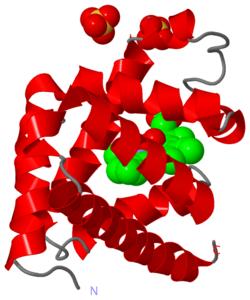JMS/sandbox15
From Proteopedia
(Difference between revisions)
| Line 12: | Line 12: | ||
'''Their hypothesis was that whales''' and other aquatic animals can hold their breath for so long because they can store more oxygen in their muscles by increasing the concentration of '''[[Myoglobin]]''', the protein that stores oxygen in muscle tissue. | '''Their hypothesis was that whales''' and other aquatic animals can hold their breath for so long because they can store more oxygen in their muscles by increasing the concentration of '''[[Myoglobin]]''', the protein that stores oxygen in muscle tissue. | ||
| - | Specifically, they predicted that species could increase the concentration of myoglobin by increasing its solubility through increasing the number of positively charged | + | Specifically, they predicted that species could increase the concentration of myoglobin by increasing its solubility through increasing the number of positively charged regions on the protein's surface, so that there would be repulsion between the myoglobin protein even at high concentrations, which would prevent aggregation and precipitation. |
| - | '''Amazingly, | + | '''Amazingly, they found an association''' between an animals' ability to hold its breath, higher concentrations of myoglobin in muscle tissue, and an increase in its net charge (taken as a ''proxy'' for an increase in the number of positively charged regions on the surface). Typically, purified terrestrial mammal's myoglobin has a solubility of 20 mg/g in an aqueous solution at neutral pH ([http://www.sigmaaldrich.com/content/dam/sigma-aldrich/docs/Sigma/Product_Information_Sheet/2/m0630pis.pdf Sigma Aldrich]) which turns out to be the maximum level of myoglobin found in most terrestrial mammal's tissue. But whales and other aquatic mammals far exceed this solubility limit, e.g., whales have 70 mg/g. The way that they overcome the solubility constraint may be traced back to a modest increase in the net charge of myoglobin - from around +2 in terrestrial animals to around +4 in aquatic animals. |
'''Molecular Tour:''' | '''Molecular Tour:''' | ||
| - | The ability of an increase in number of positively charged | + | The ability of an increase in number of positively charged regions to enable higher solubility is a known phenomenon<ref>doi: 10.1073/pnas.0402797101</ref>, and this study is consistent with previous reports<ref>PMID: 14741208</ref>. The aquatic animals have increased their number of positively charged regions through key substitutions of neutral amino acids for positively charged amino acids, and of negative amino acids for neutral or positive amino acids. We present one such manifestation of this overall trend, by comparing the elephant and whale myoglobin structures. |
Out of 27 divergent amino acids between whale and elephant's myoglobin - from a total of 153 amino acids - only 8 of these amino acids lead to changes of charge. These eight amino acids are shown for whales and elephants, <scene name='57/575026/Electrostatics/19'>side by side</scene>. Arginine and Lysine have a charge of +1, aspartic and glutamic acids have charges of -1, and histidine in positions 12 and 116 have a charge of about +0.5 (supplementary Table S2 <ref name="whaleMyo" />). The whale amino acids, have an illustrative eletrostatic field drawn around the <scene name='57/575026/Electrostatics/17'>electrically charged atom</scene> in the residue. Note that the effective size of the electric field of the charged atom at the end of residues like lysine is actually larger, because of the multiple conformations a long residue <scene name='57/575026/Electrostatics/17'>like lysine</scene> moves between. Next to the whale amino acid, the <scene name='57/575026/Electrostatics/18'>elephant residues</scene> are shown in yellow halos and labelled with the residue name. From studying the differences between these two proteins, it is clear that the whale protein has more areas with a positive electrostatic field. These positive electrostatic fields are <scene name='57/575026/Electrostatics/19'>scattered about the surface</scene> of the whale protein, and will repel any whale myoglobin, preventing the protein-protein interactions that lead to aggregation. | Out of 27 divergent amino acids between whale and elephant's myoglobin - from a total of 153 amino acids - only 8 of these amino acids lead to changes of charge. These eight amino acids are shown for whales and elephants, <scene name='57/575026/Electrostatics/19'>side by side</scene>. Arginine and Lysine have a charge of +1, aspartic and glutamic acids have charges of -1, and histidine in positions 12 and 116 have a charge of about +0.5 (supplementary Table S2 <ref name="whaleMyo" />). The whale amino acids, have an illustrative eletrostatic field drawn around the <scene name='57/575026/Electrostatics/17'>electrically charged atom</scene> in the residue. Note that the effective size of the electric field of the charged atom at the end of residues like lysine is actually larger, because of the multiple conformations a long residue <scene name='57/575026/Electrostatics/17'>like lysine</scene> moves between. Next to the whale amino acid, the <scene name='57/575026/Electrostatics/18'>elephant residues</scene> are shown in yellow halos and labelled with the residue name. From studying the differences between these two proteins, it is clear that the whale protein has more areas with a positive electrostatic field. These positive electrostatic fields are <scene name='57/575026/Electrostatics/19'>scattered about the surface</scene> of the whale protein, and will repel any whale myoglobin, preventing the protein-protein interactions that lead to aggregation. | ||
Revision as of 19:47, 28 April 2014
| |||||||||||
References:
- ↑ 1.0 1.1 Mirceta S, Signore AV, Burns JM, Cossins AR, Campbell KL, Berenbrink M. Evolution of mammalian diving capacity traced by myoglobin net surface charge. Science. 2013 Jun 14;340(6138):1234192. doi: 10.1126/science.1234192. PMID:23766330 doi:http://dx.doi.org/10.1126/science.1234192
- ↑ Brocchieri L. Environmental signatures in proteome properties. Proc Natl Acad Sci U S A. 2004 Jun 1;101(22):8257-8. Epub 2004 May 24. PMID:15159533 doi:http://dx.doi.org/10.1073/pnas.0402797101
- ↑ Goh CS, Lan N, Douglas SM, Wu B, Echols N, Smith A, Milburn D, Montelione GT, Zhao H, Gerstein M. Mining the structural genomics pipeline: identification of protein properties that affect high-throughput experimental analysis. J Mol Biol. 2004 Feb 6;336(1):115-30. PMID:14741208 doi:http://dx.doi.org/10.1016/S0022283603014748

